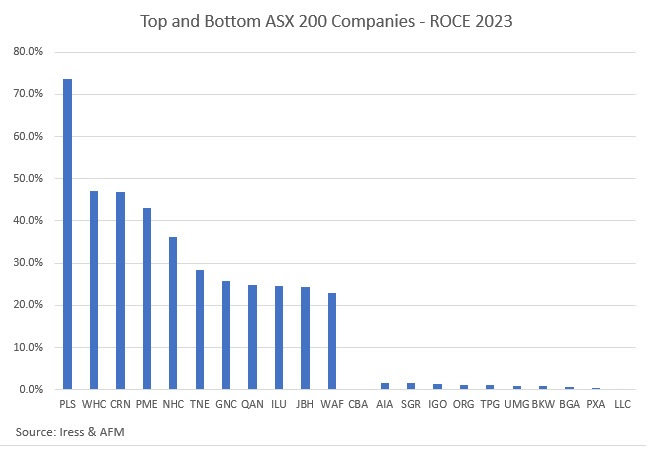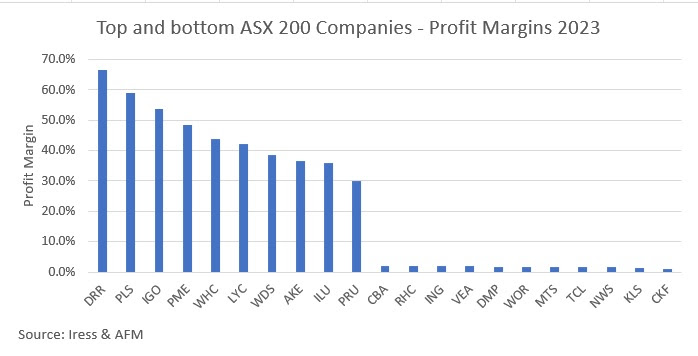A dive into reported profits
Last month, Commonwealth Bank (ASX: CBA) reported a record annual after-tax profit for the 2023 Financial Year of $10.1 billion. CBA's profit result was viewed as controversial by some Corporate earnings' obscene' as CBA posts record profit, say Greens. However, this specious analysis ignores the fact that the "large" headline profit number must be divided by the 1.67 billion CBA shares on issue.
Whilst large corporations generate large profits in dollar terms, what is often ignored in much of the debate on corporate profitability is that these profits must be shared amongst millions of individual shareholders. In this piece, we are going to look at different measures of corporate profitability for large Australian listed companies, looking beyond the billion-dollar headline figure, which frequently does not tell investors how efficiently management is running the business or how well they are using the capital given to them.

Different Measures of Profitability
Investors should look at growth in earnings per share, as often, a company's profits can grow substantially when it makes an acquisition. However, if that acquisition is funded by issuing a large number of additional shares, profit per share might not actually grow. This has been the case with fund manager Perpetual (ASX: PPT), which has increased net profit over the past five years from A$116 million to A$163 million in 2023. However, earnings per share have declined from $2.46 to $1.97, as the increase in profit was derived from acquisitions funded by dilutive equity issuances.
Conversely, a company's profits may be down, but if this is due to the selling of a non-core division, it could be a good result for shareholders. In 2019, Suncorp (ASX: SUN) sold its smash repairs and life insurance businesses, with the proceeds recycled into a share buy-back and a special dividend. Suncorp has increased annual earnings per share by +15% despite selling two businesses since 2019.
At a company level, we also look at measures such as returns and profit margins, which can be better measures of how efficient a company's management team is at generating its annual profits. Furthermore, these measures allow the investor to compare companies in similar industries. For example, the profit margins of Coles (ASX: COL) and Woolworths (ASX: WOW) or NAB (ASX: NAB) and Westpac (ASX: WBC) are compared on results day to evaluate how the different management teams are navigating the prevailing economic conditions.
Return on Capital Employed
.jpg)
The common factor in these businesses is high commodity prices, low or no debt and minimal ongoing capital expenditure to run the company. The three coal companies are in an interesting position. Typically, high commodity prices result in takeovers and significant capital expenditure to expand existing mines, both of which result in higher levels of debt and equity issuance that expand a company's capital base. However, due to difficulties in getting approvals to expand mines and concerns about banks at some stage in the future refusing to lend to coal companies, management teams had paid down debt. This places the companies in a net cash position. Additionally, the companies have conducted on-market buy-backs to shrink their capital base. This results in high return on capital positions for the three coal miners.
Bringing up the rear is a range of capital-heavy businesses that require both large amounts of initial capital to start the business and regular capital expenditure to maintain the quality of their assets and finance their ongoing activities. For the purposes of this analysis, Atlas has only included companies that generated a profit in FY2023. This subset includes food companies (Bega and United Malt Group), a construction company (Lend Lease), a telco (TPG) and an embattled casino company (Star Entertainment).
Typically, when looking at this measure, miners, steelmakers, wineries and airlines are prominently featured amongst the lowest returning businesses as they are operating in capital-hungry industries. However, in 2023, some companies in these industries are currently enjoying cyclically strong earnings. Return on capital employed is a measure not used to evaluate banks due to the sheer size of total assets on the bank balance sheet used to generate profits – in CBA's case, 2023, $1.25 trillion.
Profit margin
.jpg)
From the above chart that looks at the profit margins for ASX for June 2023, the highest profit margins are generated by companies that are miners operating low-cost mines enjoying commodity prices (PLS, IGO, Whitehaven and Lynas), a royalty trust (Deterra), medical software (Pro Medicus) and energy company (Woodside).
Mining and energy companies enjoy high profit margins, as once the large offshore LNG trains or mines are built and operating smoothly, these assets have a low marginal cost of production per barrel of oil or tonne of ore. This metric does not account for the tens of billions in upfront capital required to build these giant projects. The highest margin company on the ASX 200 is Deterra Royalty Trust (ASX: DRR), which is somewhat of an anomaly in that it does not actually operate an iron ore mine in the Pilbara but rather collects a quarterly royalty payment of 1.23% of the value of iron ore sold by BHP mined in its royalty area.
Low-profit margin companies characteristically receive large revenues but operate in intensely competitive industries such as grocery retailing (Metcash), fast food (Dominos Food, Collins Food) labour intensive healthcare and engineering (Ramsay Health, Worley), and petrol retailing (Viva Energy). Toll road operator Transurban (ASX: TCL) made the list in 2023, making a minuscule profit despite toll roads being very profitable and high-margin businesses. Typically, the company's $1 billion non-cash depreciation charge on their profit and loss statement and the small $100 million annual maintenance capex charge allow Transurban to avoid making a statutory profit yet deliver healthy free cash flows to pay distributions to shareholders.
Generally, companies with low profit margins are obviously forced to concentrate closely on preventing their profit margins from slipping, as a small change in their margins is likely to impact the profit available for distribution to shareholders significantly.
Our take
While the banks and the large miners (BHP and RIO) generate large absolute profits, resulting in headlines around the billions of dollars they earn, they are generally not among the most profitable large listed Australian companies in terms of profit margins and returns on assets. Over the last six months, Commonwealth Bank's 53,754 employees produced a $10.5 billion profit, representing a return on assets of 0.8% and a profit or net interest margin of only 2.07% on a loan book of $926 billion.
3 topics
11 stocks mentioned

